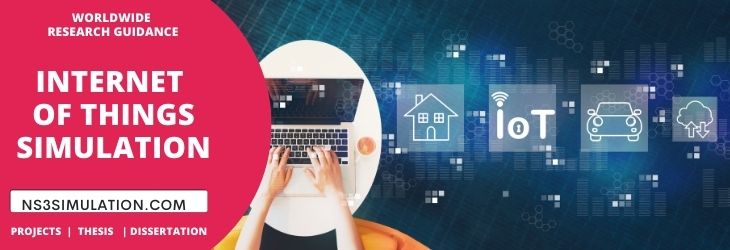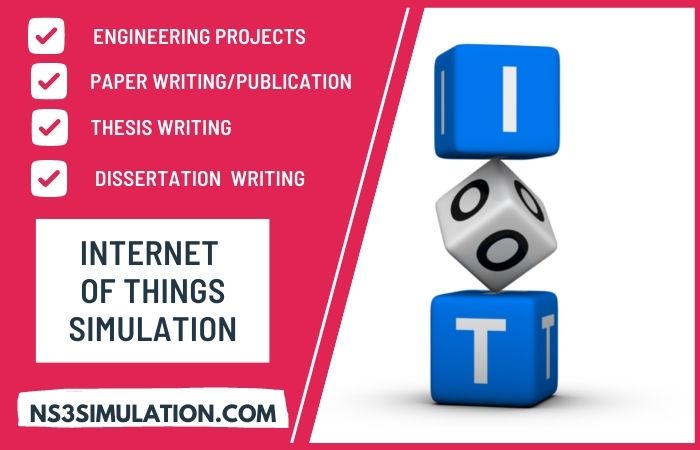The Internet of things (IoT) is a technology of interconnecting physical things with the environment and living things for effective data sharing. For that, it comprises digital sensors, actuators, base stations, access points, software, and more in the network. On the whole, Internet of Things Simulation uses internet access for exchanging information within the network.
This page is about the new research updates on the internet of things simulation and developments!!!
Now, let’s see things that we follow in simulating IoT projects. The below-specified information is very important while developing IoT projects. Since it figures out all primary operations involved in a basic IoT system.

- Connection of IoT devices
- Connect the IoT devices through suitable wired / wireless technologies
- Observe sensed data
- Sense the data from surrounding through deployed sensor
- Data Transmission
- Distribute the data to the edge / fog / nearby devices in the network by utilizing efficient communication technology
- Information Analytics
- Analyze the data though learning and cognitive approaches at network edge
- Information Value
- Assess the data by means of intelligent techniques
Next, we can see the required essential skills for developing Internet of Things Simulation projects. Our developers have more experience in dealing with IoT simulation regardless of complexity. In the following ways, our developers regularly update their knowledge for achieving the best project.
Our Skills for IoT Simulation
- Replicate the real network environment through simulation
- Collect the past information of the sensors from the database and analyze them while emulating the network.
- Concurrently examine the multiple blocks of the projects
- Assess both the simulation and emulation outcome by comparing with real devices
- For instance: in the case of smart city application, the whole city information is effectively assessed by the intelligent data analytics techniques
What is IoT simulation?
In the absence of physical devices, IoT Device Simulator enables us to build, test and deploy any kind of customizable IoT application. In this, it facilitates to virtually reproduce the original environment in all aspects. In the time of large-scale simulation, we need to focus on the sensor’s heterogeneous nature. Though it comprises different networks in one place, it insists to use well-refined tools and technologies for efficient simulation.
In some cases, the internet of things simulation causes various technical issues by means of qualitative and quantitative aspects. In the coming section, we will discuss how large-scale IoT projects are simulated in the real world with their key approaches to improve scalability. Now, let’s see how the IoT infrastructure is reproduced in the real world through the IoT prototype.
How to simulate IoT environment?
- Deploy the essential IoT devices and execute them
- Enable the repositories and connect the existing system in the virtual framework
- Visualize the simulated environs through appropriate software development
Internet of Things Simulation
When we work on complex internet of things simulation, we require sophisticated testbeds that support both small and large-scale networks. Since the nodes will communicate with each other and increase the network size in some scenarios. So, when you handpick the IoT simulator ensure the scalability feature.
Why Emulate / Simulate IoT?
In IoT developments, the Cooja tool is used for simulation purposes and Enzo Unified tool is used for emulation. These tools help to build and analyze any kind of real-time scenario. If required, it is also ready to include the real devices in the testbed and verify the behavior of the network. Now, we can see the internet of things simulation tools and technologies that offer a sophisticated framework for smooth implementation.
Simulation Tools used for IoT
- Contiki and VMware
- Open-sourceoperating system which is specially meant for internet of things simulation
- Comprises in-built toolboxes modules, libraries for both simple and complex system development
- Provide Instant Contiki that runs on Linux OS (VMware) with an assurance of maximum safety and efficiency
- Supportive Protocols: CoAP, RPL, IPv6, 6lowpan and IPv4
- CupCarbon
- Discrete event simulator with the ability of multi-agent
- Enable to integrate IoT with Wireless Sensor Network (WSN)
- For instance: Smart city
- iFogsim
- Cost-free and open-source software
- Well-suited for developing IoT enabled medical applications
- Cooja
- Part of the Contiki which is used for programming contiki
- Simulation tool to design and simulate any number of Contiki motes without considering network capacity
- Here, the motes are referred as the sensors, microcontrollers and other wireless devices
- Utilize pre-defined libraries (developed in C) for connecting network components
- Control the devices used in the network through C programming
- NS-3
- Discrete event network simulator – 3
- Support fast and efficient prototyping
- NetSim:
- User-friendly network simulator
- Provide graphical user interface (GUI) to simplify the code work
- Easy to develop custom based protocols for real and non-real applications
- MATLAB
- Matlab Simulation enables model optimization
- Simple to implement any sort of complex mathematical operations
In addition, our developers also have given the code development tool that is used for emulation purposes in internet of things simulation. In comparison to simulation tools, emulation has the facility to incorporate real physical devices in the time of the simulation.
Emulation Tools used for IoT
Enzo Unified and SQL Server.
- Enable the virtual mesh of IoT sensors
- Framework to treat data in the form of service
- Empower the execution of T-SQL commands
- Establish the interaction among Azure IoT Hub and Sql Server
- Support data visualization in all emulated live IoT network
- Facilitate to integrate cloud with IoT platforms through cloud interface
- Key Characteristics:
- Cross platform Communication
- Fast Transmission and Emulation
- Robust and Secure
- Asynchronous Logging
- Data Distribution to particular IoT process
Once the IoT simulation/emulation is achieved, it generates the experimental results after thorough analysis. These results are represented as charts, log files, tables, and graphical depictions to understand the actual performance of the system. If required, all this information can be analyzed further for specific needs using intelligent learning techniques. Here, we have given the list of testbeds that is used for verifying the algorithm/techniques efficiency and also help to evaluate the overall network performance.
Testbeds used for IoT Simulation
- JOSE
- Environment – Outdoor Platform
- Concurrency – Support Multiple Services
- Usability – Monitor the Surrondings
- Scale – Wide-Range (support infinite number of IoT devices)
- Smart Sanatander
- Environment – Real-world
- Concurrency – Service Allocation and Practical Examination
- Usability – Build and Simulate Smart City Environment
- Scale – Wide-Range (support 20,000 IoT devices)
- FIT IoT-LAB
- Environment – Lab based Platform
- Concurrency – Support Multiple Users
- Usability – Inspect the algorithms / protocols
- Scale – Moderate (support beyond 2,700 IoT devices)
Next, our resource team has shared the key objectives of the IoT which are addressed in the majority of the IoT Research projects. Along with these aims, it also included the widely used effective measures (protocols) that were used to accomplish the desired research outcomes.
Current Research Objectives of IoT
- Energy-Awareness
- LoRa
- EnOcean
- Weightless
- SigFox
- IEEE 802.11ah / 802.11ba / 802.11af
- DECT Ultra Low Energy (ULE)
- Ingenu
- Bluetooth Low Energy (BLE)
- Lightweight Standards
- uIP
- NanoIP
- Time Synchronized Mesh Protocol (TSMP)
- Routing Protocol for Low-Power and Lossy Networks (RPL)
- IPv6 over Low-Power Wireless Personal Area Networks (6LoWPAN)
- Addressing and Discovery Schemes
- UPnP
- mDNS
- EPU
- URIs
- uCode
- Hypercat
- IPv6
- Cognition
- Machine / Deep Learning (ML / DL)
- Bio-inspired Techniques
- Artificial Intelligence (AI)
- Networking
- SigFox
- Bluetooth
- Z-Wave
- Software-Defined Networking
- IEEE 802.11
- Network Functions Virtualization
- NarrowBand-IoT
- Content-Centric Networking
- LTE-Advanced (LTE-A)
- Privacy
- TRIVIUM
- CLEFIA
- ENOCORO
- PRESENT
Last but not least, here we have mentioned the core IoT research ideas which are collected from the current PhD / MS study. For your awareness, we have given just a sample of notions of Internet of Things Simulation. Beyond this, we have an infinite number of attention-grabbing IoT research topics.
Research Ideas in IoT Internet of Things
- Seamless Handoff and Handover Techniques
- Advance Design of Transport and Routing Protocols
- Optimal Cross layer Architecture Modeling
- Efficient QoS and Resource Distribution in Wireless Networks
- Mobility Architecture and Control in Internetworking
- Enhanced Dynamic Network Switching and Routing Approaches
- Development of Error Control Mechanisms for Accurate Error Correction
- Efficient Communication using Improved MAC Technologies
Further, if you are seeking more novel research ideas or development support then you can approach us for Internet of Things Simulation. Our resource team will give an immediate response to you to fulfill your requirements at the needy time.

